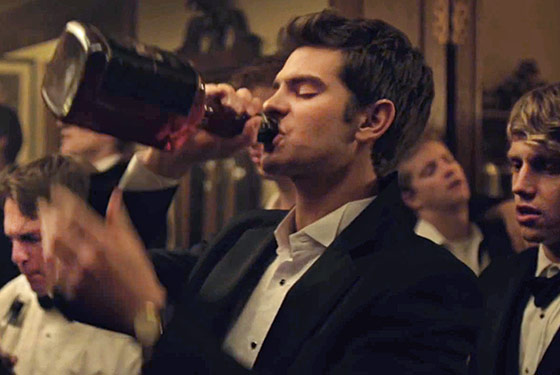
The real Mark Zuckerberg, reportedly, could not care less about final clubs, HarvardÔÇÖs super-old, highly exclusive, partially secretive, fratlike organizations that are allegedly bastions of wealth, power, and influence. But you know who does care? Vulture! And thatÔÇÖs because in The Social Network, final clubs (SPOILER ALERT?) are a big motivator for fake Mark Zuckerberg, first prompting him to distinguish himself on campus through his web projects, and second, pushing him to jealously oust his final clubÔÇôadmitted pal Eduardo from Facebook. SlateÔÇÖs Nathan Heller, who was at Harvard with Zuckerberg, has already called out the fictional ZuckerbergÔÇÖs fictional motivations: ÔÇ£Sorkin and FincherÔÇÖs 2003 Harvard is a citadel of old money, regatta blazers ┬à Zuckerberg aspires to penetrate this world in order to make fancy friends and ÔÇö well, do what, exactly? Wear madras?ÔÇØ That hasnÔÇÖt quite quelled our curiosity, though. So: What are final clubs? Who are final-club members? And are their parties as awesome as the one depicted in The Social Network? We asked a final clubsÔÇôinformed recent Harvard grad (who asked that we not use their name ÔÇö secrecy!) for answers.
How are final clubs different from frats?
There are marked similarities. The distinction is that theyÔÇÖre not affiliated with a larger national organization, and nobody lives in them. There are actually bedrooms, but only one or two people live there at most. TheyÔÇÖre definitely a similar strain.
Why are they called ÔÇ£final clubsÔÇØ?
ItÔÇÖs because back in the day, you would join the freshman club, then I forget what the middle stage was, and then you join the final club your senior year. So the name is a relic of a different era.
How many members do they have?
About twenty per year, for sophomore through senior year. So it fluctuates between 60 and 40 at what time of year youÔÇÖre talking about.
Are certain clubs more desirable than others?
ThatÔÇÖs roughly true, but the tastes are somewhat idiosyncratic. I donÔÇÖt know that thereÔÇÖs a clear order that everyone would agree on. The one that they mention in the movie as the best is the Porcellian ÔÇö thatÔÇÖs the club that the Winklevosses were in. That was certainly true in 1912. At this point, itÔÇÖs not really. ItÔÇÖs got the richest tradition, itÔÇÖs the oldest, but at this point it doesnÔÇÖt really occupy that prominent of a place. ItÔÇÖs the most restrictive in terms of allowing in non-members for certain parties, so it appeals to a certain type. A lot of people would rather be in the club thatÔÇÖs more fun, less reminiscent of the 1870s.
What about the clubs is actually secret?
TheyÔÇÖre not all that secretive. Everyone knows who the members are, everyone knows where the buildings are, most of them have parties and invite non-members, all of them have spaces where they bring non-members. There are secret spaces. Every club has at least some space thatÔÇÖs technically members-only. The ratio of secret to non-secret space varies from club to club. The clubs are exclusive and a lot of the parties are exclusive. But itÔÇÖs not really that exciting. ItÔÇÖs just a college party, you know? There are secret initiation rituals, but again, at least in my experience, nothing really crazy happens. ItÔÇÖs a glorified fraternity. A little snootier, a little more into the traditions.
How do you get in?
At the beginning of the fall, mostly sophomores and a few juniors, too, will get invited to the first punch event of any particular club. Generally each club punches 200 to 250 people in the first round. After the fourth round [of cuts], theyÔÇÖll accept about 25. You donÔÇÖt sign up or declare publicly that youÔÇÖre interested. You might ask your friend to punch you, but thatÔÇÖs generally considered crass. The idea is that if youÔÇÖre friends with people in final clubs, then theyÔÇÖll punch you.
So you donÔÇÖt actually have to do anything to get the final clubsÔÇÖ attention?
If you do a thing that gets you noticed, thatÔÇÖs great. But the vast majority of people that are punched, itÔÇÖs not because they did something remarkable.
What did you think of the movieÔÇÖs depiction of final clubs in general?
They get the overall feel right. Obviously its a little sensationalized. The biggest final club scene is at what they claim is the Phoenix. The exterior shot is the Spee, not the Phoenix, and the interior shots are neither the Spee nor the Phoenix. But of course, who cares  theyre buildings. They have the bouncer at the front whos got an ear piece waving in all those girls  obviously that doesnt really happen. There arent really buses of BU girls that come in. And they certainly dont look like the girls in that movie. And then the parties themselves are less debauched than in that kind montage. There are generally fewer naked girls. Everythings a little tamer.
One last thing: The guy whoÔÇÖs talking during the party scene is wearing a backwards hat and a suit, which seemed like a strange choice. Does the backwards hat have any final-clubs significance?
People in jacket and tie are ubiquitous at Harvard, and final clubs tend to have events where you have to wear jackets and ties, and each final club has its own tie. I think they got the right tie in the movie. The backwards hat? I guess he just wanted to wear a backwards hat.

